Menu
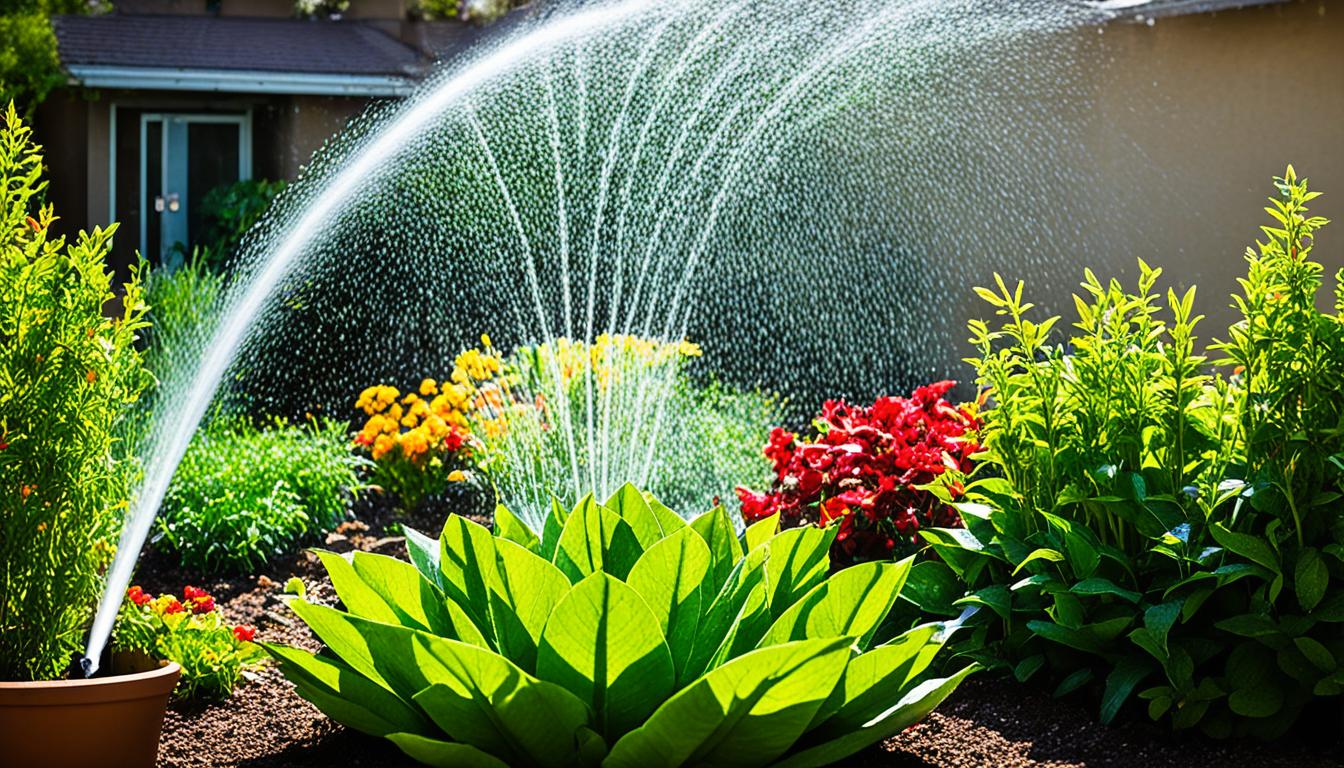
Each morning, my garden teaches me about the balance between beauty and sustainability. It shows me how nature connects with our latest technology. This connection leads us to use water in smart ways, helping our gardens and the environment. We’re learning to water our plants in a way that is good for all life around us.
With freshwater becoming scarcer, due to urban growth and climate change, the need for sustainable watering is clear. By using eco-friendly sprinkler systems, farms can cut down on water use significantly.
Such systems help in efficient farming. They cut down on water waste. This benefits the environment, making plants stronger against diseases. It also helps reduce farming costs.
Additionally, they help in saving energy. For example, using stuff like variable frequency drives (VFDs) and solar pumps.
Sustainable watering is good for nature. It helps keep soil healthy, improving its ability to hold nutrients. This means our soil stays fertile for the future, helping biodiversity survive.
Many consumers care about buying from eco-friendly farms. So, farms using smart irrigation get noticed. This can help them sell their products at better prices. Plus, it’s good for the planet and their pocket.
In a world focused on saving water, eco-friendly sprinkler systems are vital. They help keep gardens and lawns hydrated responsibly. These systems are great for saving money and helping plants grow strong.
Eco-friendly sprinklers save lots of water, up to 50% less than old ways. They’re very precise, making sure water goes only where it’s needed. This helps save water and promotes using water the right way.
These sprinkler systems also save you money. They use water wisely, so your bills go down. It’s an easy and smart way to do affordable gardening that’s good for plants.
Plants need the right amount of water to grow well. Eco-friendly sprinklers provide just that. They help plants make strong roots and keep them healthy.
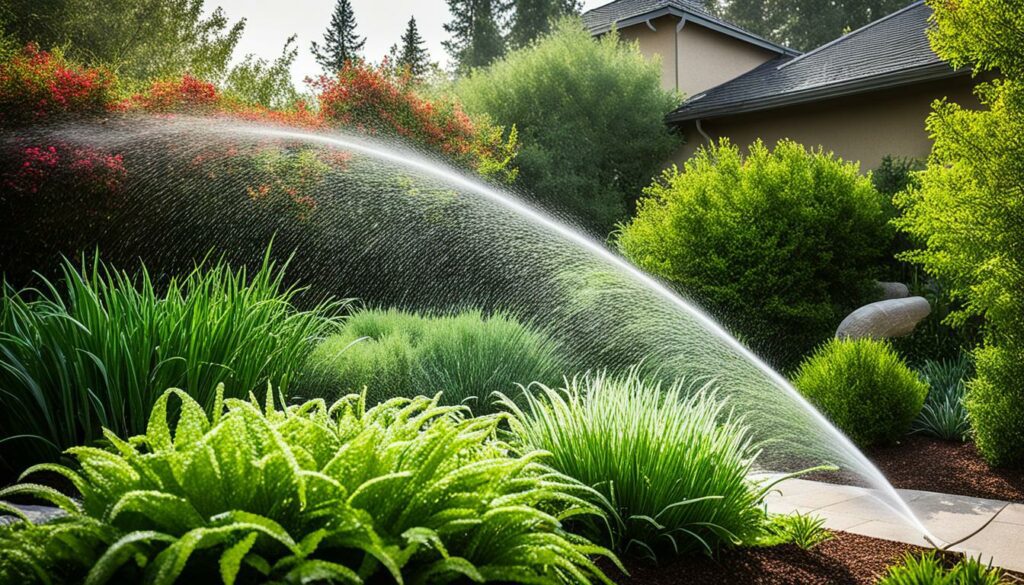
Runoff is a big issue, especially in cities. It can harm waterways. Eco-friendly systems handle water better, cutting down runoff. This protects our water and helps with water saving efforts.
| System Type | Water Efficiency | Runoff Reduction | Cost Savings |
|---|---|---|---|
| Traditional Sprinklers | 60% | Low | Minimal |
| Eco-Friendly Sprinklers | 75% | Moderate | Significant |
| Drip Irrigation | 90% | High | Maximum |
When picking plants for your garden, choose ones that need little water. Use organic irrigation methods and add drought-resistant plant species. This helps your garden be more sustainable.
These plants do well in hardiness zones from 3 to 10 and 9 to 11. They come in different shapes and sizes. This fits many water-efficient landscaping styles.
They bloom from summer to autumn, with some flowering all year in warmer areas. They need full sun to partial shade. So, they suit various planting spots.
These plants are easy to care for, keep deer away, and love dry areas. They use less water and help in sustainable gardening. They are a smart, affordable choice for any garden.
Using organic irrigation methods and these plants can make a strong, water-efficient landscape. Plus, they attract helpful pollinators like bees and butterflies. This makes your garden better for the environment.
Drought-resistant plant species are both beautiful and useful. For instance, lantana flowers come in many bright colours. They make your garden look lively.
Drip irrigation systems are all about smart water use. They send water right to the plant roots. This stops water waste and saves a lot of water.
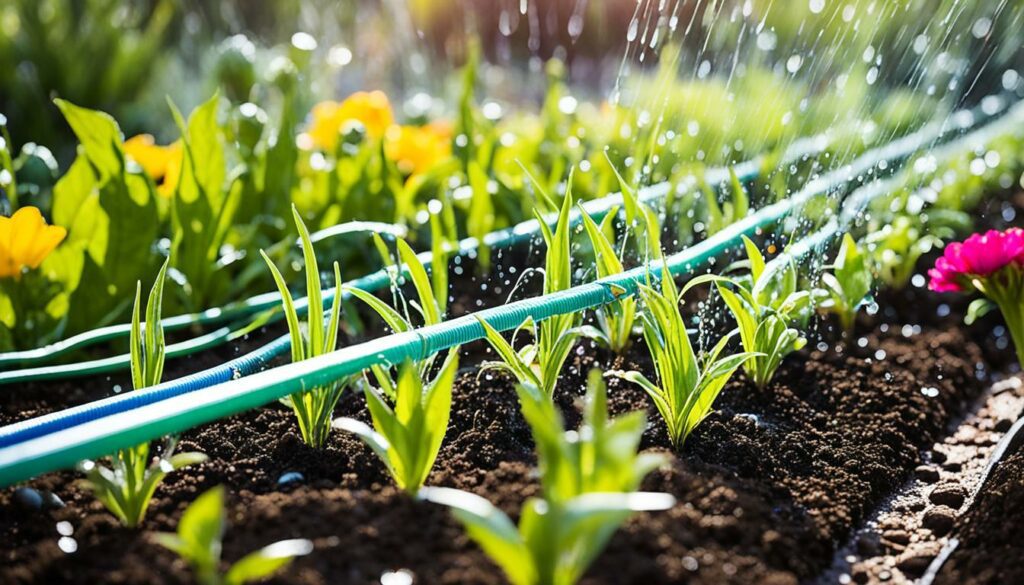
This system sends water to exactly where the plants need it, their roots. Water and nutrients are used better this way. It makes plants grow healthier. A report by National Geographic shows it can increase plant yields by 20% to 90%.
Drip irrigation is really good at using water efficiently. An MIT study found it had a 90% efficiency rate. This is much better than traditional watering (60%) or sprinklers (75%). It saves up to 80% of water, important in places where water is scarce.
Drip irrigation also cuts down on water evaporating. It does this by sending water straight to the soil. This is much better than sprinklers that lose lots of water to the air. It keeps the plants moist without wasting water.
Using drip irrigation helps in being eco-friendly. It saves water and uses less energy. These systems run on low pressure. So, they don’t need as much coal or natural gas.
In conclusion, drip irrigation is great for saving water. It’s good for gardeners and the planet. It helps in farming sustainably.
Being a gardener, I’ve learned how smart controllers and sensors can transform watering. They help use water better by adjusting when to water based on the weather and soil. This way, your garden is not just good but outstanding.
Automated irrigation systems are amazing because they water plants only when needed. They save 30 to 50 percent of water, which is a lot, especially in places like Oklahoma. Also, special controllers can cut back water use by another 20 percent. This makes them very eco-friendly.
Using soil moisture sensors helps control when to water by tracking soil moisture. These sensors usually cost between $99 and $165 but save a lot of money by saving water. They can cut back watering by 72 percent and save up to 34 percent more water during droughts. This means plants get watered only when they really need it, which helps their health and growth.
Smart controllers can also change how much they water based on the weather. For example, products like the Hunter Hydrawise HPC-400 and the Rachio 3 Smart Sprinkler Controller can manage different garden zones. In Las Vegas, Nev., using these tools can keep grass looking good in hot summers while using 43 percent less water.
These smart watering tools are key to having a beautiful, water-wise garden. They not only save water but also lower your bills. It’s the smart and eco-friendly way to garden today.
Rainwater harvesting is a smart way to irrigate gardens sustainably. It goes beyond saving water. It cuts water bills, lessens runoff, and improves plant health. This technique shows a deep care for our environment.
It’s simple and smart to collect rainwater. A 1,000-square-foot roof gathers 300 gallons from just half an inch of rain. A smaller garage roof, 20′ x 30′, can get 360 gallons from an inch of rain.Many use IBC totes, which hold 275 gallons, for storage. Rain barrels are easy to use but need upkeep to stay clean. Remember to empty them in winter to avoid breakage from ice.
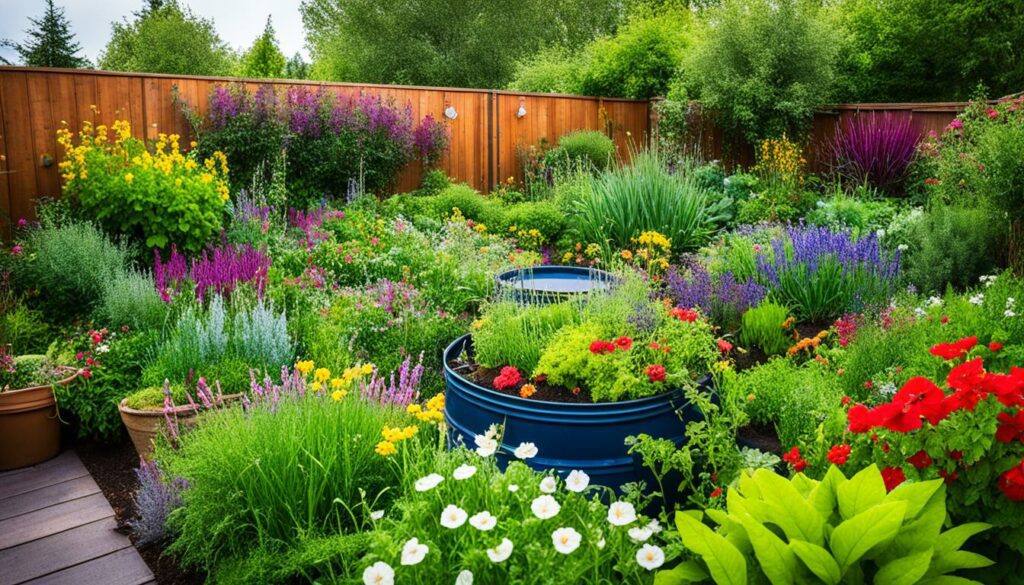
Using rainwater for gardens has many upsides. It’s great for slow watering perennials. Rainwater lacks tap water chemicals. It has nutrients vital for plant health, like nitrogen. This method eases off local water systems and saves energy, lowering water bills.
Rainwater tanks and barrels are key for green gardening. Placing tanks high can improve water flow. But, it’s essential to keep rainwater clean. Use netting or strainers to keep out debris and insects. Include first flush diverters and filters for pure water, especially in cities.
Using these methods lets gardeners work with nature. It makes gardening both sustainable and friendly to the planet.
Unusual weather, like New Zealand’s wet year and Australia’s changing rain, shows why we need to use water wisely. Rainwater is a great way to save money and protect the environment. It’s perfect for reducing your water bills and helping during dry spells.
Rainwater harvesting is getting more popular because it has lots of benefits. You can collect rain in barrels or bigger tanks to use later on. This water can help with many tasks at home, like watering the garden or washing cars. By doing this, you use less of the water that comes from the town, cutting costs and helping the planet. With time, you’ll save a lot of money.
Rainwater is soft and has no chlorine, which is good for gardens and more. It also helps the local environment by putting water back into the ground and feeding ecosystems. Plus, it lessens the harm from heavy rain, like soil washing away or streets flooding.
Through rainwater harvesting, homeowners not only achieve cost-effective watering solutions but also participate actively in environmental conservation techniques.
When using rainwater at home, you typically follow steps like collecting, cleaning, and finding ways to use it. Places often give out money or tax breaks to push for these green water methods. In Guelph, Canada, for example, there’s a program that refunds up to $2000 for systems that save water all year round. This helps with things like flushing toilets, doing laundry, and watering plants.
Rainwater collection is nothing new but it’s more important than ever. It makes us less dependent on others for water. Over time, it makes a big difference for the planet and your wallet. By choosing the right system, you can save lots of water and money, while also helping the environment.
| Benefits | Description |
|---|---|
| Cost Savings | Significantly lowers utility bills and municipal water dependency. |
| Water Conservation | Reduces strain on public water supplies and minimises stormwater runoff. |
| Environmental Impact | Supports local ecosystems, reduces flooding, and replenishes groundwater. |
| Improved Water Quality | Rainwater is naturally soft and free from chemicals like chlorine. |
| Self-Sufficiency | Provides homeowners with their water source, promoting independence. |
Biodiversity-friendly irrigation links advanced watering methods with what our local environment needs. It supports wildlife and native plants. This method fits well with the UN’s 2030 Agenda for Sustainable Development. It tackles nine of the seventeen global goals.
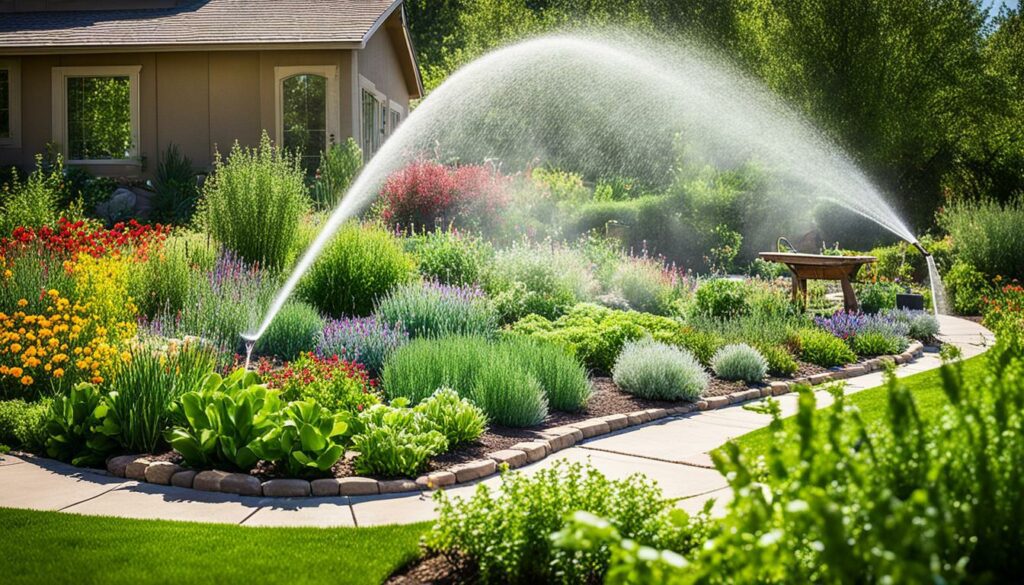
Precision irrigation is much more efficient. It delivers water directly to the roots of plants, which is key for conservation gardens. This way of watering helps fight water shortages and uses fewer resources. It also boosts crop produce and quality.
Companies such as Netafim are at the forefront of green farming techniques. They meet ISO Standard 14001 and carry out full Environmental Impact Assessments. Their work is all about honesty, duty, and respect. This supports fair practices within and outside the company.
“Precision irrigation offers a powerful solution, enabling farmers to achieve higher yields with less water while contributing significantly to local biodiversity conservation,” said a sustainability expert.
Since agriculture uses 70% of fresh water, we can reduce this number with smart watering. These methods keep ecosystems balanced, which helps many species.
Using precision irrigation for conservation gardening is crucial. It supports local wildlife and fits into the global push for sustainability. This leads to a stronger, greener future.
Modern irrigation tech changes how we save and share water in our gardens. High-tech systems help gardeners save and spread water better. They use eco-friendly tools to make sure each plant gets just the water it needs.
Eco-friendly tools are key for earth-friendly gardening. They cut down on how much damage we do to the world. Precision irrigation alone can save 40% of water. This was found by the Journal of Irrigation Science. That’s a big step in green gardening, helping us waste less water.
Getting water where it’s needed is essential for pretty gardens. Using micro-irrigation like drip systems can save 30% to 70% more water. Places like California and Australia have seen a huge difference, with up to 50% water saving. China is also doing well, saving 40% more with these systems.
| Method | Water Savings (%) | Implementation Areas |
|---|---|---|
| Precision Irrigation | Up to 40% | Global |
| Micro-irrigation (Drip) | 20-50% | China, USA, Australia |
| Micro-sprinkler Irrigation | 20-50% | India, Africa |
| Integrated AI Systems | 25% | Various Regions |
Keeping an eye on our irrigation tools and looking after them is vital. Thanks to AI, we can use smart sensors to watch moisture levels. This way, our plants get exactly the right amount of water. This cuts down on waste and keeps our gardens healthy with less water.
AI-run systems also mean we don’t have to do as much hard work, saving money. They can move where the water goes with amazing accuracy. This approach has been able to save half the water often used before. And, by looking at soil and weather, AI tells us the best way to water the plants.
Large gardens that aim for sustainability need to cover many areas, especially when it comes to water management in large landscapes. One big step is to design the garden to collect rainwater on a large scale. This takes the load off city water supplies. It’s a key part of making a garden sustainable.
At Advanced Pavers & Landscape, over 50% of customers have asked for eco-friendly solutions in the last year. One customer saw a big drop in their water bills after getting an advanced watering system from the company. This shows how important smart water use is for big gardens.
Using drip irrigation or tiny drip systems helps water plants exactly where they need it. This cuts down on water lost through the air. Putting mulch on garden beds keeps the soil moist. Rain barrels collect water in a green way for the plants. These methods fit well with eco-conscious garden design.
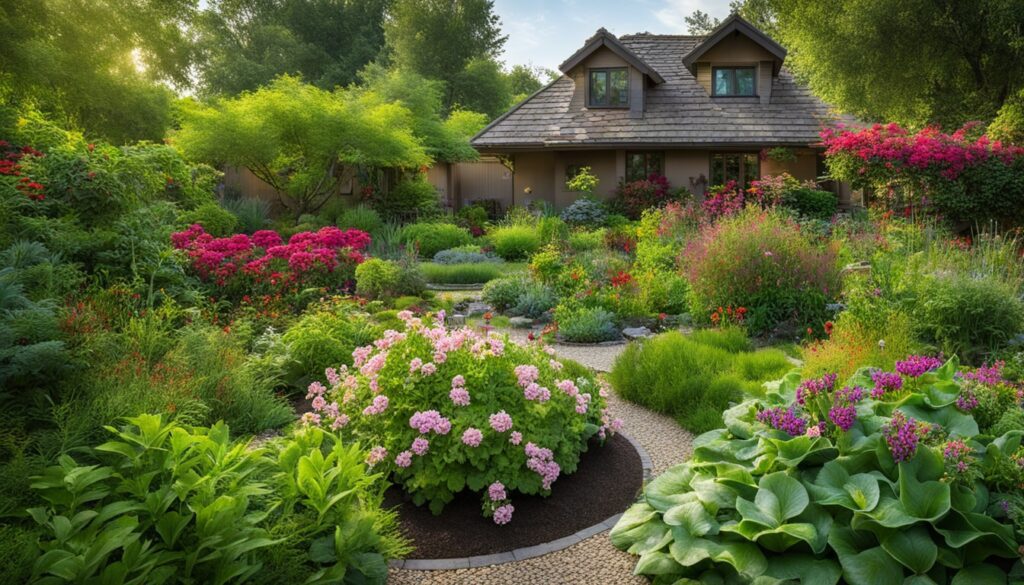
A case study showed that using 90% native plants in a garden cuts down on work by half. This means less work and a more sustainable garden. Also, using Integrated Pest Management (IPM) cut down on chemical use by 60%. These steps are huge for the environment.
Landscape experts should aim to get materials made in a sustainable way. Using items from old projects again is smart and well-liked by customers. Designing for lots of different plants and animals adds life to the garden. It also makes the space more interesting for customers.
Here’s a comparative table showing some great sustainable practices:
| Practice | Benefits |
|---|---|
| Drip Irrigation | Minimised water loss, precise delivery |
| Rain Barrels | Cost-effective water source |
| Mulching | Improved soil moisture retention |
| Native Plants | Reduced maintenance needs |
| IPM | Reduced chemical use |
Using these strategies is crucial for anyone dealing with a large garden. It keeps the garden in line with the goals of extensive garden sustainability. It also helps the garden stay healthy over time and saves important water.
Timely watering is key for a sustainable garden. It picks the best times for watering plants. This cuts down water loss. Plants get the right amount of water, making them healthier. And it saves water too.
Water in the early morning or late evening for best results. The air is cooler then, and it’s usually less windy. This helps the soil keep its moisture. It also gives plants what they need to do well day and night.
Watering in the evening or morning is a smart move. It uses water more efficiently. This fights against water loss. It also helps plants grow strong because they get water when they need it most.
Timely irrigation makes your garden healthier and planet-friendly. When you water smartly, you help both your plants and the environment. It’s a win-win situation, using water well and keeping plants happy.
| Timing | Benefits |
|---|---|
| Early Morning | Maximises absorption, reduces evaporation |
| Late Evening | Ensures moisture retention, lowers water waste |
| Night | Optimal for soil moisture, prevents rapid evaporation |
For more about sustainable gardening through timely irrigation, check detailed resources. They explore smart ways to water plants and other good garden care tips.
Adding pumps and wells to a garden’s water system is great for the environment. It helps use underground water well. This method lowers the use of city water. It fits perfectly with sustainable water systems and water-friendly pumps. The parts from Red Lion are strong and last a long time. They help avoid needing new pumps often. This reduces waste.
Red Lion’s pump parts help in big ways. They make using less water possible, especially in garden watering. This is key for saving water in places like farms. Also, Red Lion uses materials that don’t harm the planet. Their effort helps the environment on a larger scale.
David is an expert on water pumps. He knows a lot about different pump types. These include pumps for clean water and pumps for farming. Using experts like David can help improve how water systems work. This can make farms produce up to half more foods.
Using the sun to power water systems is smart and green. Solar pumps, like the ones from Sprinktech, are good for the Earth and save money. They don’t harm the air and are less costly to run. Plus, they can work on farms both big and small. They can even be checked and controlled from far away. This makes them fit different farming needs well.
Biodiversity-friendly irrigation mixes modern tech with green aims. It does this to fulfil plant needs while looking after the land. This method is encouraged by groups such as Rainscapes. It leads to saving lots of water and helping many different animals and plants.
There’s less clean water because of cities and changing weather. Using water well in farming and protecting nature helps keep a healthy water supply. This is important for our environment.
Eco-friendly sprinklers use half the water of older systems. This saves money and helps plants grow strong. They also stop dirty water getting into local rivers.
Plants used to dry weather need less water. These include special plants that don’t need much watering. Using these kinds of plants and watering methods helps the environment.
Drip systems send water straight to plant roots. This stops water from disappearing into the air. It’s a clever way to water plants while saving water.
Smart devices work out when to water depending on the weather and soil. They take care of plants without wasting water. This helps plants stay healthy and saves water.
Using rainwater means needing less from the town’s water supply. It’s cheaper and better for the planet. By saving rainwater, gardens can be watered in a green way.
By using rain for watering, there’s less need for paid water. This is good for the wallet and the environment. It’s an affordable and green way to water gardens.
Biodiversity-friendly irrigation works with nature rather than against it. It makes sure the land stays healthy while watering plants. This keeps everything in balance.
New watering tech uses water wisely and helps keep gardens healthy. Checking and keeping the tech up is also good for nature. It makes gardens better places for plants and animals.
Big gardens can be watered well by collecting rain and using deep water sources. Drip irrigation saves water too. These ways help the environment and make big gardens greener.
Watering at certain times stops water from vanishing too quickly. Plants get the most out of the water this way. It’s a key part of saving water effectively.
Using local water through pumps and wells can be good for the planet. It saves our clean water for other uses. This method is kind to the environment when done carefully.